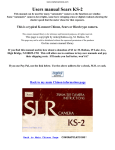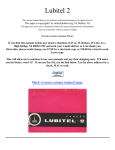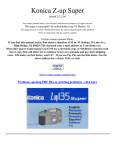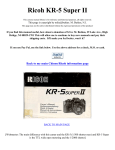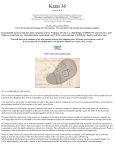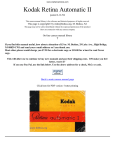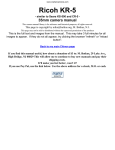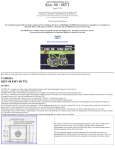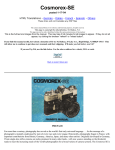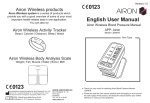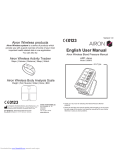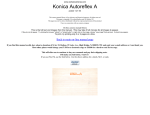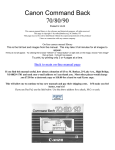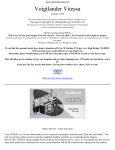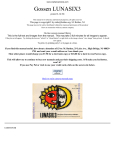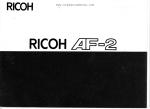Download PDF version
Transcript
www.orphancameras.com Gossen Luna-star F This camera manual library is for reference and historical purposes, all rights reserved. This page is copyright by [email protected] M. Butkus, NJ. This page may not be sold or distributed without the expressed permission of the producer I have no connection with any camera company On-line camera manual library Back to main on-line manual page If you find this manual useful, how about a donation of $3 to: M. Butkus, 29 Lake Ave., High Bridge, NJ 08829-1701 and send your e-mail address so I can thank you. Most other places would charge you $7.50 for a electronic copy or $18.00 for a hard to read Xerox copy. This will allow me to continue to buy new manuals and pay their shipping costs. It'll make you feel better, won't it? If you use Pay Pal, use the link below. Use the above address for a check, M.O. or cash. Contents Page Views of the meter cover and its controls 1 & 2 Display The display and its elements Display duration www.orphancameras.com How the LUNA-STAR F functions Preparations Battery - CINE scale (frames per second) Self-checking routine - Contrast measurement Basic values Flash measurement 4www.butkus.org Measuring range extension - Multiple flash Incident and reflected light measurement Measurements exceeding the measuring range The individual functions Display exceeding the display range Setting the film speed Setting and measuring correction values Continuous light measurement - Setting correction values - For shutter priority mode "t" - Measuring correction values - For aperture priority mode "f" Canceling correction values - Exposure value (light value) "EV" Important remarks concerning "Correction Values" Technical specifications Your LUNA-STAR F is an exposure meter with digital display from GOSSEN. It measures continuous light and flash, and it covers a wide measuring range with great accuracy. 4www.butkus.org A wealth of knowledge in the area of light metering, based on many decades of experience in the manufacture of exposure meters, is now being made available to the user, in the simplest manner possible, due to microprocessor technology. The LUNA-STAR F not only measures with the greatest accuracy, but it can also store the readings and complete calculations at the push of a button. Its operation is exceptionally simple and convenient. Features that characterize the LUNA-STAR F: Microprocessor controlled Measures reflected and incident light, flash (with cord and cordless), and the share of ambient light. Calculation of multiple flash Digital LCD display in tenths of stops Analogue contrast display in half stops Programmable exposure correction Recall of all possible paired settings for a reading Aperture or shutter priority pre-selection Extremely convenient to measure flashes Covers the entire cine scale (frames per second), including the TV standard 25 f.p.s. Warning when range is exceeded Automatic battery check Storage of settings and readings Automatic Off Display The display and its elements 1. Functions - Flash measurement - Continuous light measurement with shutter priority - Continuous light measurement with aperture priority - Continuous light measurement with read-out of exposure values (EV) - Entering the correction value - Setting the film speed 2. Digital display of film speed ASA (ISO) 3. Display identification "f" for aperture 4. Display identification "EV" for exposure value 5. Analogue aperture scale 6. Left-hand digital display www.orphancameras.com - Aperture f - Exposure value EV - Correction value steps - Film speed in DIN 7. Display identification "t" for exposure time (shutter speed) 8. Warning sign "BAT" for battery check 9. Display identification "/" for fractions of a second 10. Right-hand digital display - Exposure time t (shutter speed) - Exposure extension factor - CINE (frames per second); symbol: - Multiple flash; symbol: F at 6 - Film speed in ASA 11. Unit symbol "m" for minutes 12. Unit symbol "s" for seconds Display Duration When none of the control buttons has been actuated during the last 2 minutes, the display is automatically switched off, i.e. there are no readings. - The stored values are recalled by depressing the function or values buttons. - Renewed measurement is instantly possible when the metering button is depressed. 4www.butkus.org The values of the last measurement are stored until a new meter reading is taken. The LUNASTAR F is fitted with separate memories for continuous light and flash measurement. How the LUNA-STAR F Functions Preparations Battery The LUNA-STAR F operates with a 9 V battery (alkaline-manganese battery or corresponding rechargeable battery). Since the meter's power consumption is minimal, the battery will last for a long time. When the battery's capacity becomes exhausted, the user is warned by the "BAT" display. This means that the battery has to be exchanged at the earliest possible opportunity. Measurements cease to be possible if the display only indicates "BAT". The battery must be immediately replaced. To change the battery open the battery compartment of the LUNA-STAR F. Remove the exhausted battery. Clip the contacts onto the new battery and insert in the battery compartment. Push back the battery compartment cover. Battery changing erases all stored values. Self-Checking Routine The microcomputer performs a self-checking routine as soon as the battery has been loaded. Every possible display segment appears on the display during this routine. The duration of the self-checking routine is approximately 10 seconds, but it can be interrupted by depressing any button. The factory-programmed basic settings are automatically adjusted as soon as the self checking routine has been completed. Basic values ISO 100/21 CORR 0/1.0 f 5.6 t 1/125 EV 12 Flash D 1/60 Measuring Range Extension Extremely powerful flash and very bright continuous light can be measured by using the special diffuser (+5 stops). Change-over is automatic by the diffuser itself. Range data: Flash Continuous light (at ISO 100/21°) Normal diffuser f/1 - 16 EV -2 to +18 Special diffuser f/5.6 - 90 EV +3 to +23 (+ 5 stops) The special diffuser for measuring range extension is identified by "+5". Incident Light Measurement- Reflected Light Measurement With regard to its measuring possibilities and operation, LUNA-STAR F was conceived for professional use. Due to its swivel sensor (swivel head), the meter is easily adapted to universal service. Incident light measurement leads to particularly precise exposures. With incident light measurement the LUNA-STAR F with adjusted diffuser is pointed from the subject towards the camera to measure the incident light to guarantee a precise exposure in conformity with the correct tonal values of the subject. This is particularly important with inherently bright or dark subjects. Even in difficult exposure situations, for instance with contrasty subjects, incident light measurement with the diffuser results in far more accurate exposures to satisfy the most discerning professional requirements. Incident light measurement is also imperative with inaccessible subjects. For this purpose it is necessary to select a point that has the same lighting level as the subject. And then a meter reading is taken with the meter pointed at the same angle towards the camera as it would babe been from the subject. This very convenient method of light metering at a point with the same lighting level is highly recommendable for outdoor shots. The measurement is performed with a complete "about turn" in front of the camera so that the reading is taken with the meter pointing towards the camera, i.e. opposite the actual picture shooting direction. Incident light measurement, i.e. with diffuser, also gives a precise reading of the brightness contrast range of the lighting. Both kinds of lighting - flash and continuous light- are measured with great accuracy by the incident light method with diffuser. Parallel to this the LUNA-STAR F also offers the reflected light measuring method. In this mode the diffuser has to be removed, and the meter is pointed from the camera towards the subject. The meter now only measures the light reflected by the subject. www.orphancameras.com Consequently, the reading always depends upon the inherent brightness of the subject! This means that inherently brighter subjects are not precisely measured and therefore rendered darker. 4www.butkus.org This mode is also used to measure the subject contrast which is displayed by the LUNA-STAR F on its analog scale. If readings are to be taken exclusively by the reflected light measuring method, then it is advantageous for the professional to use a gray card (18% remission capacity) in this mode. The Individual Functions Setting the film speed o Select ISO with function buttons. o Set the desired ISO value with the values buttons. (Display: left DIN value; right ASA value) Once the film speed has been set it is transferred to the memory of the LUNA-STAR F when the meter is adjusted to any operating function, and it remains visible at the top on the right-hand side of the digital display. Any change of the film speed directly influences the stored paired aperture and shutter values. This selected film speed will be retained in the meter memory until you change it to a new setting as described above or until you change the battery. Continuous light measurement The LUNA-STAR F is designed for an exposure value measuring range of -2 to + 18/+23 (with a special diffuser) at ISO 100/21°. It offers the following possibilities depending on the application in hand: a) With shutter priority "t" the reading is taken for the corresponding aperture. b) With aperture priority "f" the reading is taken for the corresponding shutter speed. c) For exposure value "EV" the shutter speed is preselectable, and the aperture is given as an analog value d) CINE speed (frames per second) e) Contrast measurement in the function "t" The desired continuous light function can be selected with the corresponding function button. a) Shutter priority mode o Select "t" with the function buttons (the last stored value appears on the display). o Adjust the desired shutter speed with the values buttons. o Measure by depressing the measuring button M. o The measured aperture stop appears on the left-hand digital display (resolution: 1/10th stops), and additionally as a mark rounded off in the analog aperture scale. o Select other paired aperture/shutter values with the values buttons. b) Aperture priority mode o Select "f" with the function buttons. o Set the desired aperture with the values buttons. o Measure by depressing the measuring button M. o The measured shutter speed appears on the right hand digital display and on the left hand side of the digital display is the aperture you have selected plus the automatic correction in 1/10th of stops to adjust for the fixed shutter speed. o Select other paired aperture/shutter values with the values buttons. 4www.butkus.org Note: The 1/10th stop values stored from the last measurement appear when the aperture is preset. These are invalid because the valid 1/10th stops will only appear after the next meter reading is taken. c) Exposure value EV o Select "EV" with the function buttons. o Adjust the desired shutter speed with the values buttons. o Measure by depressing the measuring button M. o The measured aperture stop appears on the left-hand digital display (resolution: 1/10th stops), and additionally as a mark in the analog aperture scale. o With the value buttons select other paired aperture/shutter speed values corresponding to this Exposure Value. d) CINE speed (frames per second) o Select "t" with the functions buttons. o Select the desired speed (f.p.s.) with the values buttons. For this purpose go beyond 1/8000ths. After approx. 1 second the meter switches over to CINE speeds. The symbol appears on the display. Cine speeds are variable between 8 and 64 frames/s. o Measure by depressing the measuring button M. o The measured aperture stop appears on the left-hand digital display (resolution: 1/10th stops), and additionally as a mark rounded www.orphancameras.com off in the analog aperture scale. The displayed aperture applies to a 180 degree shutter blade. Enter a COR value for other shutter blades as an extension factor V = 180°: open aperture angle e) Measuring the contrast o Select "t" with function buttons o Keep measuring button depressed for some time and aim meter at the various areas in your subject o In the left digital display, there appears the first measured aperture (f/stop). It will stay on in the display as reference value (e.g. a neutral gray card) during the entire measuring operation. On the analog aperture scale the contrast range between the two extreme values will come on. The actual measuring value flashes. o After the measuring button is released, the entire contrast range measured is indicated on the analog aperture scale. The last value measured does not flash any longer. Contrast range of the subject: without diffuser Contrast of illumination: with diffuser on. Flash Readings Readings can be taken with or without synchronizing cable. When used in conjunction with a synchronizing cable, the flash is fired with the synch button O Select " " with the function buttons. c Adjust the desired synchronizing speed with the values buttons. Synch range from 1 s to 1/1000th s (including 1/90 s). o Depress the measuring button M. LUNASTAR F is operable for metering for a period of 45 s. (Meter readiness prevails as long as "F" remains visible on the display). o Fire the flash. o The measured aperture stop (from the sum total of flash and continuous light) appears on the left digital display, and as a flashing mark on the analog aperture scale. The aperture stop for the Share of continuous light is additionally indicated on the aperture scale (in our example f/8). - Multiple Flash Occasionally the light output from a single flash may not be sufficient to enable you to work at the aperture desired. When this happens, simply push the top values button until the desired f/number appears in the display. The digital shutter speed display disappears, to be replaced by information on the number of flashes that have to be fired for the desired f-stop (e.g. F4 = 4 flashes). The LUNA-STAR F will calculate up to a maximum of 10 flash sequences. 4www.butkus.org Measurements Outside the Measuring Range o The LUNA-STAR F will not produce any useful readings outside its measuring range. o If it is too dark or too bright, an "E" (= error) appears on the left digital display, and alongside it 54 u '' for too dark, or 56 n " for too bright. Read-out Outside the Display Range o If the symbol " U " or "n"', appears on the right or left digital display it means that a reading has been taken, but its display is outside the meter's display range. o With " u " actuate values button ( ), to enter the display range. O With " n " actuate values button ( ) to enter the display range. Setting and Measuring Correction Values (Please refer to "Important Remarks Concerning Correction Values", page 20) Setting Correction Values o Select with the function buttons "COR". (The last valid correction value appears on the display) o Enter or change the correction value with the values buttons. www.orphancameras.com The extension factor appears on the right-hand digital display, the correction value is shown on the left in steps. Enter in 1/10th steps (small figure) within a range of + 7.9 Exposure Value steps. A figure preceded by " - " indicates an exposure extending correction. In the event of an exposure shortening correction only the left display appears as an exposure value difference in steps. (Example: -3.1 steps equal factor 8.6) Measuring Correction Values Correction values can also be directly measured. An evenly illuminated surface and constant light level are required. o Aim meter at surface. o Press measuring button and get a reference reading; displayed as "rF--". o Weaken light by holding e.g. a gray filter in front of the cliff user sphere. Press measuring button. The light reducing factor will be displayed automatically in stops at the right, as extension factor at the left. The COR value is now automatically taken into account in all subsequent measuring functions. The frame around "COR" is retained as a reminder that a correction value was entered. Canceling Correction Values o Select "COP" with the function button. o Depress measuring button (display = "rF--") o Select any other function with the function button. o Correction value is canceled, and the frame around "COR" disappears. 4www.butkus.org Important Remarks Concerning "Correction Values" The LUNA-STAR F is a precision meter calibrated with great accuracy to provide you with exact exposure data. Should you still not be satisfied with the results, then you should remember that there are other independent variables that can influence the success of your exposures: For instance - The "true" speed of your film can deviate from that on the pack; - The "true" shutter speeds on your camera can differ slightly from the rated values; - The "true" f-stops on your camera can differ from the specified ones; - Deviations can arise when the film is processed. In addition to that purely subjective factors and matters of taste in the assessment of the finished photos may be involved. However, you can calibrate your LUNASTAR F to the peculiarities of your camera, your brand of film, your processing methods, and to your projector. We recommend the following procedure: Take the readings of a few normal subjects with the utmost care by the reflected and incident light measuring methods, and shoot five pictures of each subject on color reversal film. The first frame should be exposed with the exposure settings supplied by the LUNASTAR F. The exposure settings for two of the remaining shots are then increased by half an f-stop and a full f-stop, respectively, and for the other two decreased by half an f-stop and a full f-stop, respectively. Make a note of the shooting conditions. These must not change while the five shots are being taken. Now select from the processed pictures the one you consider to be optimal and compare its settings with the meter readings. If you find that you prefer exposures that were taken with settings that differ from those supplied by the meter, then this value can be programmed into your LUNA-STAR F. Technical Specifications Measuring possibilities Incident light Reflected light Flash (cord/cordless) Indication of ambient light share Calculation for multiple flash Sensor Silicon blue cell photodiode Measuring range/continuous light Equaling EV-2 (at ISO 100/21°) to +18/+23 (with special diffuser) Repeatable accuracy + 0.1 EV Exposure times 1/8000th sec. to 60 minutes Aperture stops f/1 to f/90 9/10 Measuring range/flash (at ISO 100/21) f/1 to f/90 Flash synch speeds 1 to 1/1000th sec. (measuring time) incl. 1/90 sec. Cine speeds 8 to 64 f.p.s., incl. 25 (TV) Adjustable and measurable correction values and Extension factors -7.9 to +7.9 1.0 to 240 Film speeds ISO 3/6° to 8000/40° Acceptance angle for reflected light 30° Battery (also rechargeable) 9 V; battery condition indication Accessories 1 normal diffuser, 1 special diffuser for very powerful flash and continuous lighting, case, carrying cord Battery, and Operating Instructions Dimensions approx. 128x71 x24mm Weight approx. 125 g (without battery) Care and Service Your Gossen LUNA-STAR F is a valuable precision instrument made with great care and accurately calibrated. It deserves your good care! Measuring comparisons of your LUNA-STAR F with similar or other types of exposure meters cannot be made properly without special laboratory equipment (optical bench). Do not attempt to open or repair your LUNA-STAR F. Should your LUNA-STAR F www.orphancameras.com require service, send the meter (directly or through an authorized dealer), in the original packing, if possible, prepaid and insured to: Bogen Photo Corp. 565 E CRESCENT AVE, P O BOX 506 RAMSEY, NJ 07446-0506 Telephone (973) 818-9500 4www.butkus.org A brief description of the reason for sending the meter should accompany the package. Optional accessories to widen the scope of your LUNA-STAR F: 5° SPOT Attachment Reduces the measuring angle of your LUNASTAR F from 30° down to 5° for reflected light measurements and enables you to accurately frame in the viewfinder the part of the subject to be measured. The 5° SPOT Attachment is suitable for both ambient and flash light measurements: Measuring range (ISO 100/21°): Ambient light EV 3 to 23 Flash f/5.6 to 90 (Item No. V066) Combination Pouch This combination pouch (Item No. V067) is available from your local dealer for ready access storage of the LUNA-STAR F with mounted 5° SPOT Attachment. (Item No. V067) +5 Measuring Range Extension for Reflected Light Measurement This attachment permits the measuring range of the LUNA-STAR F to be extended by 5 steps when measuring the light reflected by the subject. In this manner even very bright light will be measured perfectly. Measuring range (at ISO 100/21°): Ambient light EV 3 to 23 Flash f/5.6 to 90 (Item No. V106)














